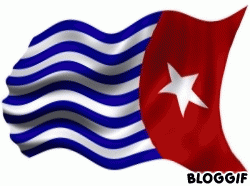 |
| Papuan |
Indonesia is home to an estimated 50-70 million indigenous peoples,
but the government does not recognize the rights of its indigenous peoples and
claims that none live in Indonesia. In a response to the United Nations
Periodic Review in 2012, a four–year human rights check-up for all countries,
Indonesia said: "The Government of Indonesia supports the promotion and
protection of indigenous people worldwide... Indonesia, however, does not
recognize the application of the indigenous peoples concept...in the country."
The UN's report recommended that Indonesia should ratify ILO Convention 169,
the only international law for indigenous and tribal peoples. In addition, the
UN recommended that Indonesia should secure the rights of indigenous peoples,
especially to their traditional lands, territories and resources.
"The Rainforest Foundation Norway
thinks President Yudhoyono would show great international leadership by
ratifying the ILO 169 Convention. The President has already made a big
commitment to reduce Indonesia's green house gas emissions by 41%. We are sure
that this ambitious goal would be strengthened if the President also signs ILO
169 and acknowledges the important role Indigenous Peoples play in managing
forests sustainably, " says Hege Karsti Ragnhildstveit, the head of
Rainforest Foundation Norway's Division for Southeast Asia.
ILO 169 is a convention of the
International Labor Organisation, which is part of the UN. The Convention
recognizes the land ownership rights of indigenous peoples, and states that
they should not be forcibly evicted from their territories. ILO 169 sets a
series of standards for the treatment of indigenous peoples and requires
governments to consult indigenous peoples on projects that affect them.
Governments that ratify the Convention are legally bound to abide by it.
The United Nations Declaration on the
Rights of Indigenous Peoples is also an important international tool, setting a
benchmark by which the treatment of indigenous peoples can be judged. However,
unlike ILO 169, the Declaration is not legally binding.
The incessant international demand for
commodities, such as palm oil and pulp and paper, is responsible for evicting
indigenous peoples off their lands and for the wholesale liquidation of
Indonesia's remaining rainforests. Indigenous peoples are not adequately
consulted or compensated for the use of their traditional lands. Large-scale
land acquisitions for palm oil operations are rife with social conflicts due to
unresolved disputes over land tenure, resource control and environmental
degradation. Forest dwelling communities are often faced with violence and
intimidation. Some palm oil companies respond to land conflicts with local
communities by using company security forces or hiring military units to crack
down on dissenters in order to keep their palm oil operations active.
The ILO 169 is the only international law
that recognizes the land ownership rights of indigenous peoples. ILO 169 is not
just a law for indigenous peoples; it is a law for everyone. It plays a key
role in saving the world's natural ecosystems, putting control of the land back
in the hands of the people who have looked after it for generations. Indigenous
peoples are thoughtful and skillful partners of the natural world; their ways
of life have protected and conserved some of the world's most intact natural
ecosystems, species and genetic diversity. Indigenous peoples' territories
cover up to 22% of the planet's land surface, and they coincide with areas that
hold 80% of the planet's biodiversity (Sobrevila 2008). It is no coincidence
that so much of the world's rainforests and biodiversity are on indigenous
peoples' lands. Scientific studies based on satellite data have shown that
indigenous territories are highly effective and vitally important for stopping
deforestation and forest fires (Nelson A, Chomitz KM 2011). Using satellite
data from forest fires to help indicate deforestation levels, the study showed
rates were lower by about 16% in indigenous areas between 2000-2008. Its
analysis shows how deforestation plummets to its lowest levels when indigenous
peoples continue living in protected areas, and are not forced out.
Recently, the Indonesian Constitutional
court ruled that the customary forests of indigenous peoples should not be classed
as falling in "State Forest Areas." This means that the State cannot
expel indigenous peoples from their customary forests. The court ruling
recognizes indigenous peoples' land rights in the archipelago and opens the way
for a major reallocation of forests back to the indigenous peoples. The
judgment was made in response to a petition filed with the court by the
national indigenous peoples' organization AMAN (Aliansi Masyarakat Adat
Nusantara). It is time for the President and the government of Indonesia to
secure and recognize indigenous peoples' land rights.







No comments:
Post a Comment